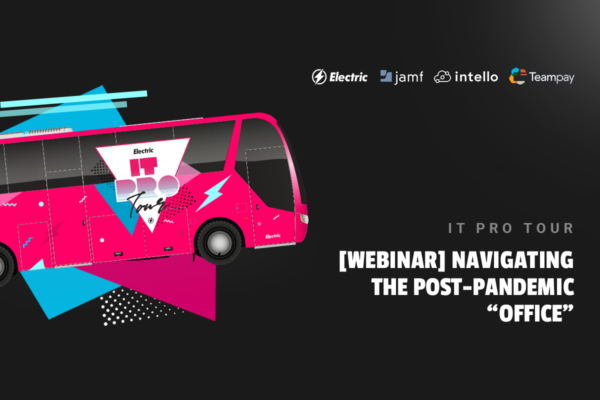
At Electric, we’re dedicated to providing a space for IT professionals at all levels to discuss the challenges and successes they’ve had in the industry. In this installment of our virtual IT Pro tour, we brought together a group of seasoned technical leaders to discuss navigating the post-pandemic office.
Much to everyone’s surprise, we have found ourselves in a situation where the office of the future has arrived much earlier than expected. Business leaders are all trying to figure out how to navigate it in a way that works best for business continuity and company morale.
Electric CEO, Ryan Denehy moderated the discussion and was joined by:
- Allen Houchins – IT Director, Jamf
- Peter Nesbitt – VP of Finance, Teampay
- Shlomo Dalezman – CTO & Co-founder, Intello
Read further to see what these highly-respected professionals have to say about the office of the future in a series of 6 questions.
1. What steps can be taken to help home offices become an extension of their organizations?
Allen Houchins led the discussion to this question by stating, “As things open up, we’ve got to be prepared for a large population of our employees to not want to come back full time.” Houchins went on to suggest that every individual, every team, and every company is different.
All the panelists agreed that there are key guidelines that companies should start thinking about as we move toward a remote focused work culture. Houchins believes there are two key questions to ask at this time:
- What can we do to keep our employees productive and comfortable as if they were in the office?
- How can we re-evaluate how our physical offices are set up?
He went on to explain that our offices need to be more of a service we provide to employees who work either remotely or take a hybrid approach. He also suggested that with fewer people in the office at a time, organizations should begin to think about how to set up the office in a way that is geared towards experiences that employees can only get outside of their home work environments.
The panelists agreed that not every employee who is working from home has access to a separate office, second computer, office chair, etc. and that companies need to find a way to make working from home just as comfortable as coming into the office.
2. How can organizations can more visibility into their IT environment when teams are working remotely?
Shlomo Dalezman hit the nail on the head when he said, “I do truly believe that IT is core to this transformation.” Dalezman continued to lead the discussion on this question by explaining that IT is crucial in a remote environment because you need software.
He further went on to explain that there are three factors companies need to look at when it comes to IT visibility:
- Identity and Authentication
- Operations and Insights
- Access Controls
The panelists all agreed that it is important for companies to control who has access to information, servers, and software as well as monitor which tools are underutilized and where money is being spent on IT.
3. What does the approval process look like for employees who need equipment for remote work?
Peter Nesbitt began the discussion by explaining that he has noticed “three ways that people have really been managing this approval process.” Nesbitt said the first is a traditional expense reimbursement system. He said the problems with this approval method is that it is labor-intensive and it assumes employees have access to cash or credit until the company can repay them.
The second approval method is a stipend through payroll. While this is an easier method, it is the least efficient because the money is typically taxable income. Nesbitt also pointed out that this is the least fair method because expenses may vary depending on geographical location.
The third method is a spend management system, such as Teampay. Nesbitt believes this tends to be the best of both worlds because employees request funds for a specific request. If approved, the employee receives a company card of their choice to make their purchases. Employees aren’t having to spend their own money and companies are able to see requests that have been made and how the money has been spent.
Houchins mentioned that his company has shipped office equipment to employees. The panelists agreed that either their companies have also shipped equipment or they know of companies utilizing this method.
4. How can organizations make Work From Home ‘forever’ possible from an IT perspective?
This discussion was geared around whether it is possible to make work from home permanent from an IT perspective. Allen Houchins said, “There are two major things that companies can look into to make work from home forever possible that will get them 95% of the way there.”
Houchins went on to explain that the first is implementing zero-touch onboarding experiences for new employees. This means looking into ways to not only ship the hardware to employees but implement ways for them to access the software they need quickly and easily. Houchins also mentioned minimizing anything that anchors employees to specific locations.
Houchins second factor involves implementing security models like Zero Trust to account for the fact that employees will not always be working from the office.
5. What elements of IT should companies prioritize automating?
Dazelman said that when it comes to automating IT, “The first to me, is just device onboarding.” He went on to explain that this should include deciding how to automate the onboarding process so that it is seamless for new employees and figuring out how they will have easy access to the software they need when they need it.
The other question that came up among the panelists is determining how to handle employees who want to purchase a $10-$15 dollar a month tool that will make their lives much easier. Do you provide monthly allowances for supplies, tools, and such? The consensus was that it will be different for every company and be based on their capabilities.
6. Where have you seen IT spend increase/decrease over the last couple of months?
Nesbitt led this discussion by mentioning that his observations have found that while there might be a slight dip in some spending, like dropping down to free versions of software instead of paid versions, overall IT spending is holding steady. He even said that he’s noticed, “A ton more expenses related to home office setups.”
The panelists agreed that IT spending is likely to hold steady or even increase due to the fact that the role of IT has become much more of a foundational need in terms of enabling remote work.
Conclusion: IT is now integral in implementing a strong WFH culture
Each panelist felt that IT plays a significant role in helping companies implement effective “work from home” cultures now more than ever.
One panelist even mentioned that if any company is looking to flip the script on what is expected— now is the time to do it.
To get more insight, be sure to join the IT Pro community on Slack.


